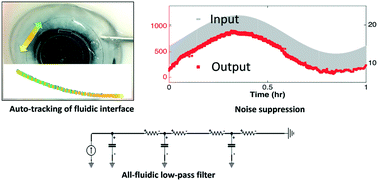Flow stabilization in wearable microfluidic sensors enables noise suppression†
Abstract
Dilatometric strain sensors (DSS) that work based on detection of volume change in microfluidic channels; i) are highly sensitive to biaxial strain, ii) can be fabricated using only soft and transparent materials, and iii) are easy to integrate with smart-phones. These features are especially attractive for contact lens based intraocular pressure (IOP) sensing applications. The inherent flow stabilization of the microfluidic systems is an additional advantage suitable for filtering out rapid fluctuations. Here, we have demonstrated that the low-pass filtering in microfluidic sensors improves the signal-to-noise-ratio for ophthalmic applications. We have fabricated devices with a time constant in the range of 1–200 seconds. We have demonstrated that the device architecture and working liquid viscosity (10–866 cSt) are the two independent factors that determine the sensor time constant. We have developed an equivalent circuit model for the DSS that accurately represents the experimental results thus can be used as a computational model for design and development of microfluidic sensors. For a sensor with the time constant of 4 s, we report that microfluidic signal filtering in IOP monitoring applications can suppress the rapid fluctuations (i.e., the noise due to ocular pulsation, blinking etc.) by 9 dB without the need for electronic components.

- This article is part of the themed collection: Wearable and Implantable Sensors


 Please wait while we load your content...
Please wait while we load your content...